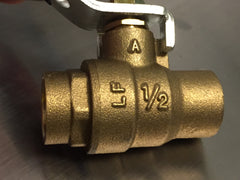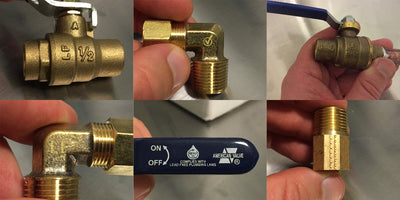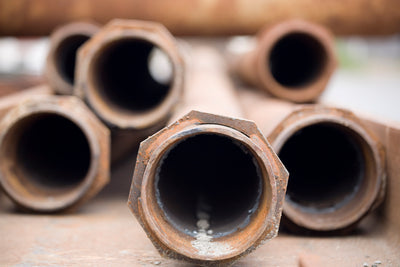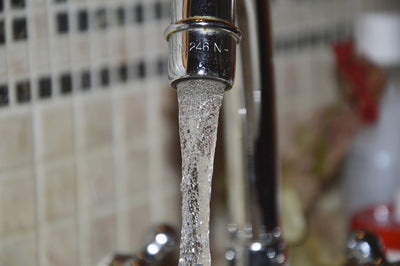LuLu Brezzell | Guest Contributor
Editor's Note: This article is part of an initiative to include stories on our blog that connect water quality issues to the everyday lives of real people. To raise awareness of the 3 year anniversary of the beginning of the Flint Water Crisis, Flint resident LuLu Brezzell describes the roller coaster ride that her family and fellow Flint residents went through once they realized that their water was not safe to drink. Ms. Brezzell was gracious enough to share her story with our audience, and was not paid to do so.
Fear
Fear, the feeling that takes over when you are told that your water source that flows into our home was filled with lead and bacteria. The same water we have been using to drink, cook with, and bathe. Fear, the feeling of knowing that your children may have been exposed to an invisible, tasteless, odorless poison that can cause irreversible damage. As a parent, there is no greater fear.
This is the same fear that I'm sure every single member of my community felt.
What Happened?
Three years ago, as part of a cost-cutting measure, a state-appointed emergency manager made the decision to switch Flint's drinking water from Detroit's municipal water to the Flint River. Flint's water plant hadn’t treated raw water in decades, never mind the fact that it was not equipped to manage industry standard corrosion control measures that would prevent corrosive river water from eating away at Flint's aging infrastructure.
On the day of the water supply switch, the emergency manager, mayor and other council members all gathered at the Flint Water Plant, and ceremoniously toasted each other with glasses of the new tap water.
Who could have expected that this toast would mark the day that our city lost its access to clean safe water?
Visible Symptoms Hinting At A Much Larger Citywide Problem?
Soon after the switch, my youngest child, who wasn’t even two years old, started to have serious issues with her skin, including persistent rashes that OTC treatments couldn't stop. She was eventually prescribed a steroid ointment that slathered onto her, and wrapped her up like a mummy with plastic wrap. It was horrible, in part because we had no idea what was causing the problem.
Here's the short answer: It was the water she was bathing in.
Shortly thereafter, we had the US CDC, EPA, MDEQ and other agencies all in our home, taking water samples and asking questions in an attempt to diagnose what was causing these issues. We weren't alone in this, it was happening all over our City. It was like watching a horror movie, where you have no idea what was going to happen next.
Our city was in the midst of a widespread water contamination emergency.
An Inspiring Call For Help
My other daughter (8 years old at the time) became very concerned with what she saw happening in Flint, and felt like she needed to do something. Here I am feeling helpless and my child is begging me to let her do something to help.
So help we did! We participated in protests and rallies to raise awareness of the water crisis. We would go out and find people passing out water and jump in a volunteer with them. We made videos and took pictures that we could share on social media.
One day we heard about a bus traveling from Flint to Washington, DC for the congressional hearing for Governor Rick Snyder. My daughter thought that if we were going to go to Washington, DC... it would probably be worth it to write a letter to (then) President Obama. About a week before the trip, she sent the letter, and I was careful to remind her that President Obama was very busy, and that he probably wouldn't be able to read it. The trip to DC came and went as planned, and a good learning experience.
But soon after we returned to Flint, we got a call...
From the White House.
President Obama was touched by her letter and wanted to come to Flint to meet her and to see first hand what was being done for the water crisis.
Flint In The National Spotlight
When that letter was released so much changed, because The Flint Water Crisis was now in the spotlight. Up until that point, I had been begging outside groups to come in and do testing (we didn't trust the testing that the city was conducting). Once the story hit the national news, things changed. We were getting emails and messages offering us water filtration systems, testing, and other products. It was so hard to keep up with everything. I was overwhelmed but grateful that finally it felt like someone was listening and wanting to help.
Navigating Conflicting Voices In A Storm Of Information
Unfortunately, some people saw the media spotlight and chaos as an opportunity to make a name for themselves, or even worse... profit from the situation.
Like anyone, I wanted answers and was willing to listen to everyone who claimed to have a solution that could fix our problem. It's easy to look back and say that I should have focused on certain opinions and ignored other voices, but it's important to remember that at the time... it was complete chaos, and even though we were grasping at straws, we were hopeful that the next straw grasped could be the solution we were looking for.
Looking back, I feel fortunate that while others were making names for themselves, an outsider with no ties to Flint was willing to remain in the shadows while helping me weed through and understand all of the information.
What Lies Ahead For Flint's Tap Water?
It's been 3 years since Flint made the fateful water supply switch that turned an entire city upside down.
Unfortunately, it's much easier to make a mess than it is to clean it up.
Our city's pipes are irreparably damaged, and we're learning that it's not as easy as digging them up and replacing them. Precautions must be taken in the meantime to ensure that no addition exposure occurs as the pipes are swapped out. It's also important to remind ourselves that replacing the service lines will not do anything to fix any lead-containing solder, valves, or plumbing fixtures inside our homes. The official recommendation is that we continue to filter our water for lead, but I know that some residents continue to rely on bottled water.
Another problem that has gone largely unpublicized is that the city is having a hard time maintaining disinfectant levels in the water, which means that some areas have noticeably high chlorine levels while other parts of the pipe network have virtually no residual chlorine to keep the water sterile.
Right now, several city and state officials are under investigation for the alleged roles they played in the Flint water crisis.
Tap water is something that most of us take for granted, but producing clean water at the municipal level is more complicated than most realize. Because of what we have gone through, I don’t think I will ever trust tap water ever again.
What's Changed In Our Home?
In the year since the letter not much has changed regarding how we use water. We still don’t use the tap water at our house for consumption. Showers are limited to 2 minutes because of how sensitive my families skin is to the water, even when filtered. Bottled water is still a very big part of our everyday lives. As much as an inconvenience as it is to constantly open up bottles of water it has almost become second nature.
On the activism and awareness front, my daughter is still doing her part to raise awareness of water quality issues, and to be a voice in support of quality science.
Other Articles We Think You'll Enjoy
Pittsburgh's 2016 Citywide Lead Levels Exceed EPA StandardsHow To Tell If Your Home's Plumbing Has Lead In It















